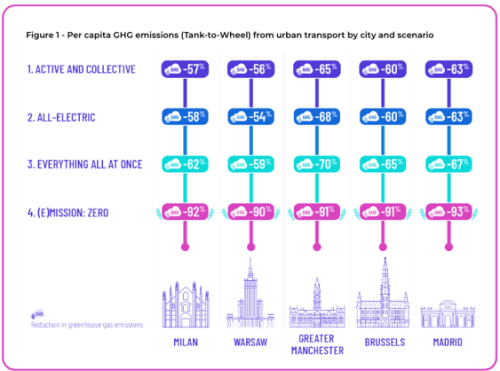Modelling European cities’ pathways to zero-emission urban mobility by 2030 through the development of potential transition scenarios
This study modelled European cities’ pathways to zero-emission urban mobility by 2030 through the development of potential transition scenarios. Each scenario is built on different set of sustainable policy measures, whose impacts is quantified through a series of indicators as output results.
 The assessment is realized through MOMOS a quantitative tool which allows to simulate and quantify in a simplified way the impacts of potential mobility transition scenarios in cities.
The assessment is realized through MOMOS a quantitative tool which allows to simulate and quantify in a simplified way the impacts of potential mobility transition scenarios in cities.
 Four potential scenarios, each one with a different focus and a specific combination of policy measures, have been simulated and applied to five real European cities: Brussels, Madrid, Milan, Greater Manchester, and Warsaw. An in-depth data collection defined and reproduced the city characteristics at the base year, including socio-demographic aspects as well as mobility features.
Four potential scenarios, each one with a different focus and a specific combination of policy measures, have been simulated and applied to five real European cities: Brussels, Madrid, Milan, Greater Manchester, and Warsaw. An in-depth data collection defined and reproduced the city characteristics at the base year, including socio-demographic aspects as well as mobility features.
The main output of the study consisted in the calculation of the CO2 emissions reduction associated to each scenario. Besides that, a series of core indicators have also been calculated for the 2030 horizon. These included: modal split, public and private fleet electrification, car ownership, road safety, and air pollutants emissions.
In addition, multi-criteria cost effectiveness analysis estimated costs and benefits associated to the four transition scenarios. Such analysis was based on four components: (implementation and maintenance) costs of the policy measures, environmental benefits, users’ transport costs and travel time, and revenues for the public administration and service providers.
For more information:
- Clean cities website on the (E)Mission zero study, including technical reports and factsheet results.
- Briefing of the (E)Mission zero study
- Interactive tool to explore results of the (E)Mission zero study
Projects
Project Description
CLIENT
European Federation for Transport & Environment
PERIOD
2023
REFERENTE
Stefano Borgato
borgato@trt.it


